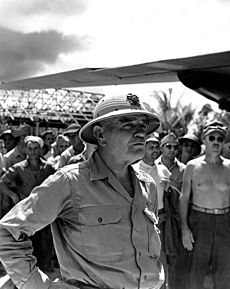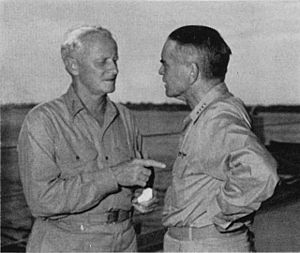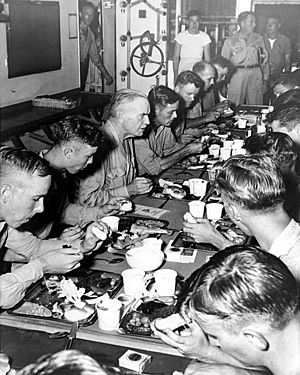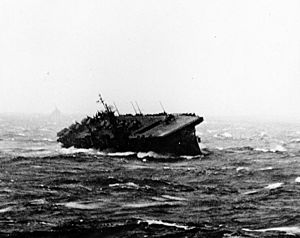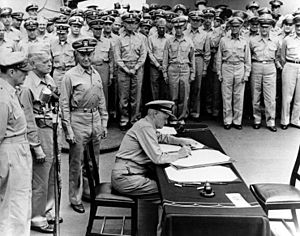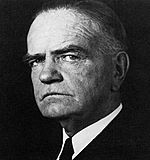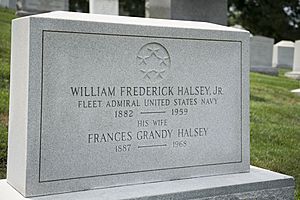William Halsey Jr. facts for kids
Quick facts for kids
Fleet Admiral
William Halsey Jr.
|
|
|---|---|
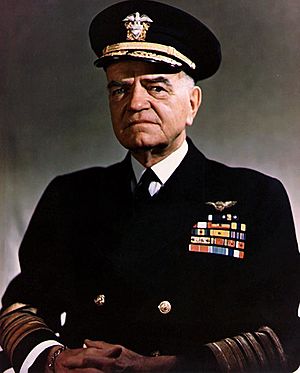
Fleet Admiral William Frederick Halsey Jr. c. 1945
|
|
| Birth name | William Frederick Halsey Jr. |
| Nickname(s) |
|
| Born | October 30, 1882 Elizabeth, New Jersey, U.S. |
| Died | August 16, 1959 (aged 76) Fishers Island, New York, U.S. |
| Buried | |
| Allegiance | |
| Service/ |
|
| Years of service | 1904–1959 |
| Rank | |
| Commands held |
|
| Battles/wars |
|
| Awards |
|
William Frederick "Bull" Halsey Jr. (born October 30, 1882 – died August 16, 1959) was a famous American Navy admiral during World War II. He was one of only four officers to reach the highest rank in the U.S. Navy: fleet admiral. The other three were William Leahy, Ernest King, and Chester W. Nimitz.
Halsey was born in Elizabeth, New Jersey. He graduated from the United States Naval Academy in 1904. He sailed with the Great White Fleet around the world. During World War I, he commanded a destroyer called USS Shaw. Later, in 1935, he took command of the aircraft carrier USS Saratoga after learning to fly naval aircraft. He became a rear admiral in 1938. When the War in the Pacific began in 1941, Halsey led a special group of ships, including the carrier USS Enterprise. They carried out several important raids against Japanese targets.
Halsey became the commander of the South Pacific Area. He led the Allied forces during the tough Battle for Guadalcanal (1942–1943) and the battles in the Solomon Islands (1942–1945). In 1943, he took charge of the Third Fleet, a role he kept for the rest of the war. He played a big part in the Battle of Leyte Gulf, which was the largest naval battle in history. He was promoted to fleet admiral in December 1945 and retired from active service in March 1947.
William Halsey was born in Elizabeth, New Jersey, on October 30, 1882. His father, William F. Halsey Sr., was also a Captain in the United States Navy.
Halsey had English ancestors who came to America in the 1600s. He felt a connection to them, including Captain John Halsey, who was a privateer (a legal pirate) for the Royal Navy. William Halsey attended the Pingry School before joining the Navy.
He wanted to join the United States Naval Academy but had to wait two years. During that time, he studied medicine at the University of Virginia. He played football there and joined a fraternity. In 1900, he finally got into the Naval Academy in Annapolis. He was a talented football player and graduated on February 2, 1904.
After graduating, Halsey served on large warships called battleships. He sailed around the world with Theodore Roosevelt's Great White Fleet from 1907 to 1909. Early in his career, he was on the battleship USS Missouri when a dangerous accident happened with a gun. This made him dislike the 13th of every month, especially if it was a Wednesday.
Halsey then specialized in torpedo boats and destroyers. These small, fast ships were important for attacking larger enemy ships with torpedoes. He commanded several of these ships. His service during World War I, including leading USS Shaw, earned him the Navy Cross, a high award for bravery.
Between the World Wars
In 1922, Halsey worked as a Naval Attaché in Berlin, Germany, and later in other European cities. This meant he was a naval expert working at the American embassies. He then returned to sea, commanding destroyers in Europe.
Back in the U.S. in 1927, he served on the battleship USS Wyoming. He also commanded USS Reina Mercedes, a ship used at the Naval Academy. In 1930, he led a division of destroyers before studying at the Naval War College.
A big change came in 1934 when he was offered command of the aircraft carrier USS Saratoga. To do this, he needed to become an air observer. But Halsey decided to go further and train as a full Naval Aviator (pilot). He earned his pilot's wings on May 15, 1935, at age 52, becoming the oldest person to do so in the U.S. Navy. He believed that naval officers needed to understand aviation for future wars. He later commanded the USS Saratoga and the Naval Air Station Pensacola. Halsey was promoted to rear admiral in 1938.
World War II Leadership
Before World War II, many naval experts thought battleships were the most important ships. But Halsey strongly believed that aircraft carriers would be the main offensive weapon. He said that American carrier tactics were to "get to the other fellow with everything you have as fast as you can." He was always ready to use carriers to attack.
In April 1940, Halsey's ships moved to Hawaii. In June 1940, he became a vice admiral and commander of Carrier Division 2.
As war with Japan seemed likely, Halsey was ordered to take USS Enterprise to deliver aircraft to Wake Island. He was given permission to attack any Japanese forces he saw. A storm delayed Enterprise on its way back to Hawaii. On December 7, 1941, instead of returning to Pearl Harbor, they heard about the surprise attack on Pearl Harbor. One of their planes, sent ahead, was shot down. Halsey immediately began searching for the Japanese attackers, but they were already gone.
Early Pacific Carrier Raids
Halsey and Enterprise returned to Pearl Harbor on December 8. Seeing the damaged fleet, he famously said, "Before we're through with them, the Japanese language will be spoken only in hell." Halsey was known for being an aggressive leader. He helped boost the U.S. Navy's fighting spirit when it was most needed.
In the early months of the war, Halsey led "hit-and-run" raids against Japanese targets. His flagship was the Enterprise. They attacked the Gilbert and Marshall islands in February 1942 and Wake Island in March. In April, he supported the Doolittle Raid, the first air raid on Japan itself. This raid greatly boosted American morale. Halsey's motto, "Hit hard, hit fast, hit often," became famous in the Navy.
By May 1942, Halsey was very tired and unwell from the constant stress of command. He had a severe skin condition that made it hard to sleep. He was ordered to a hospital in Hawaii for treatment.
Meanwhile, U.S. intelligence learned that Japan planned to attack Midway Island. This was a huge threat, as losing Midway could lead to attacks on Hawaii and the U.S. West Coast. Losing Halsey, his most experienced carrier admiral, was a big problem for Admiral Chester Nimitz, the Pacific Fleet commander. Halsey recommended that Rear Admiral Raymond A. Spruance take command of his task force for the upcoming Battle of Midway. Nimitz agreed, and Spruance led the carriers Enterprise and Hornet to victory at Midway.
After recovering, Halsey returned to duty in September 1942.
Commander, South Pacific Area
Halsey was assigned to command a carrier task force in the South Pacific Area. He arrived at headquarters in Nouméa, New Caledonia, on October 18, 1942. The Guadalcanal campaign was at a very difficult point. U.S. Marines were barely holding on to Henderson Field.
Admiral Nimitz decided to replace the current South Pacific commander, Vice Admiral Robert L. Ghormley, who seemed tired and unsure. As Halsey's plane landed, he received a message from Nimitz: "You will take command of the South Pacific Area and South Pacific forces immediately."
This order was a surprise, as Ghormley was a long-time friend. But Halsey took command, which now included all ground, sea, and air forces in the area. News of Halsey's appointment greatly boosted the morale of the Marines. Halsey was known as the Navy's most aggressive admiral. He quickly made it clear that he would not withdraw the Marines from Guadalcanal. He intended to secure the island and take the fight to the Japanese. He even ordered that naval officers in the South Pacific no longer had to wear neckties with their uniforms.
Halsey led the South Pacific command through the toughest part of the war for the U.S. Navy. He used his limited forces in a series of naval battles around Guadalcanal, including the Battle of the Santa Cruz Islands and the Naval Battle of Guadalcanal. These battles stopped the Japanese advance and weakened their naval air power.
For his strong leadership, Halsey was promoted to four-star admiral in October 1942. He appeared on the cover of Time magazine, which called him "professionally competent and militarily aggressive."
In November, Halsey risked his battleships in a night battle near Guadalcanal. This paid off, as the U.S. Navy won a decisive battle that helped doom the Japanese forces on the island.
Halsey's forces continued fighting up the Solomon Islands chain to Bougainville. At Bougainville, instead of attacking Japanese airfields directly, Halsey landed his invasion force in Empress Augusta Bay. There, Navy construction battalions (Seabees) built a new airfield. When a large Japanese cruiser force came to attack the landing, Halsey had no strong surface ships to stop them. His only option was to use his carrier aircraft from Saratoga and Princeton.
Rabaul, where the Japanese ships were, was a heavily defended port. Attacking it with carrier aircraft was very risky. But Halsey sent his two carriers north and launched a daybreak raid. The mission was a huge success, damaging the Japanese cruisers so much that they were no longer a threat. Halsey called this "the most desperate emergency" he faced.
After Bougainville, Halsey's forces isolated the Japanese base at Rabaul by capturing nearby islands in the Bismarck Archipelago. This allowed the Allies to continue their advance without having to fight for Rabaul itself. With Rabaul neutralized, major operations in the South Pacific ended. Halsey's determination had helped turn the tide of the war in the Pacific.
Battles of the Central Pacific
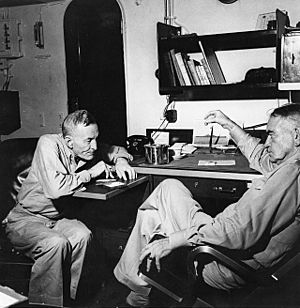
As the war moved into the Central Pacific, Halsey's command moved with it. In May 1944, he became the commanding officer of the new Third Fleet. He led operations from the Philippines to Japan. From September 1944 to January 1945, he directed campaigns to take the Palaus, Leyte, and Luzon. He also led many raids on Japanese bases.
By this time, the U.S. Navy's Fast Carrier Task Force was incredibly powerful. It could bring enough air power to defeat land-based aircraft and control any area it operated in. The Navy also set up forward operating ports like Ulithi. This allowed the fleet to stay at sea for long periods, far from home. The vast size of the Pacific Ocean, which Japan thought would protect them, could not stop the U.S. Navy.
Command of the "big blue fleet" was shared with Raymond Spruance. When Spruance was in command, the fleet was called the Fifth Fleet and the Fast Carrier Task Force was "Task Force 58." When Halsey was in command, it was the Third Fleet and "Task Force 38." This system confused the Japanese and kept operations moving quickly. Halsey was aggressive and took risks, while Spruance was more careful.
Battle of Leyte Gulf
In October 1944, U.S. forces landed on Leyte in the Philippines. Halsey's Third Fleet was ordered to protect these landings. Halsey hoped this would draw out the Japanese fleet for a decisive battle.
In response, Japan launched its last major naval plan, called 'Sho-Go'. It aimed to destroy the invasion ships in Leyte Gulf. A Japanese Northern Force, made of aircraft carriers with few trained pilots, was meant to trick the U.S. fleet away. Meanwhile, two other Japanese battle groups, the Center Force and Southern Force, would attack the invasion ships. These forces included 7 battleships and 16 cruisers. This plan led to the Battle of Leyte Gulf, the largest naval battle in history.
On October 23, the Center Force was found by U.S. submarines, which sank and damaged some ships. The next day, Halsey's carrier aircraft attacked the Center Force, sinking the battleship Musashi. The Center Force seemed to retreat but then turned back towards San Bernardino Strait. When Halsey's scout planes found the Japanese Northern Force, Halsey made a big decision. He took almost all of his Third Fleet north to destroy the Japanese carriers, leaving the San Bernardino Strait unguarded.
Battle off Samar
When the Center Force came through the San Bernardino Strait on October 25, there was only a small group of U.S. escort carriers and destroyers, called "Taffy 3," to stop them. These ships were meant to attack land targets and guard against submarines, not fight the largest enemy fleet.
In the desperate Battle off Samar, Kurita's ships destroyed one escort carrier and three screening ships. But the brave resistance of Taffy 3's ships and aircraft, even with limited weapons, convinced Kurita that he was facing a much stronger force. Mistaking the escort carriers for Halsey's main fleet carriers, he decided to retreat without completing his mission.
When the Seventh Fleet's escort carriers called for help, Halsey did not respond for over two hours. Then, he received a message from Admiral Nimitz: "Where is repeat where is Task Force 34? The world wonders." The last part was a code to confuse enemies, but it sounded like a strong criticism to Halsey. He was furious. His chief of staff, Rear Admiral Robert "Mick" Carney, told him to calm down.
Halsey eventually ordered Task Force 34 south, but they were delayed by refueling their destroyers. By the time they arrived, Kurita had already retreated. Meanwhile, the main part of Third Fleet continued north and sank all four of Ozawa's carriers in the Battle off Cape Engaño.
Halsey received criticism for his decisions during the battle, with some calling it "Halsey's Blunder." However, destroying the Japanese carriers was a key goal, and the Leyte landings were still successful.
Halsey's Typhoon
After Leyte Gulf, in December 1944, the Third Fleet faced a powerful typhoon, later called "Halsey's Typhoon."
While operating near the Philippines, the fleet had to stop refueling due to the storm. Halsey chose to stay in the area for another day, even with conflicting weather reports. He played the odds, hoping the storm would pass. On December 17, the carriers could not land their planes because of the rough seas. All aircraft were ditched in the ocean, but the pilots were saved.
The typhoon hit hardest between 11:00 a.m. and 2:00 p.m. on December 18, with huge waves and winds over 100 knots. Three destroyers were sunk, 146 aircraft were destroyed, and 802 sailors were lost. Many other ships were damaged.
After the typhoon, a Navy investigation found that Halsey had made an error in judgment by sailing the fleet into the storm. However, Admiral Nimitz decided not to punish Halsey, considering his long and distinguished service record.
End of the War
In January 1945, the Third Fleet attacked Formosa and Luzon and raided the South China Sea to support U.S. Army landings. On January 26, Halsey handed command of the fleet to Admiral Spruance, and it became the Fifth Fleet.
Halsey returned to command the Third Fleet in May 1945. In early June, the fleet sailed through another typhoon, Typhoon Connie. This time, six men were lost, and many planes were destroyed or damaged. Again, a Navy inquiry recommended reassigning Halsey, but Nimitz refused.
Halsey led the Third Fleet through the final stages of the war. They attacked targets in Japan itself, including Tokyo and the naval base at Kure. Third Fleet battleships also bombarded Japanese coastal cities, preparing for an invasion that never happened.
Halsey was present when Japan formally surrendered on the deck of his flagship, USS Missouri, on September 2, 1945.
After the War
After Japan surrendered, Halsey's flag flew from USS South Dakota as 54 ships of the Third Fleet returned to the United States for Navy Day celebrations. On December 11, 1945, he officially became a Fleet Admiral, the highest rank in the Navy. He retired from active service in March 1947.
After retirement, Halsey joined the board of some companies. He also tried to save his former flagship, USS Enterprise, as a memorial, but there wasn't enough money to do so.
Personal Life
While at the University of Virginia, Halsey met Frances Cooke Grandy, whom he called "Fan." They married on December 1, 1909. They had two children, Margaret Bradford and William Frederick Halsey III.
Death
William Halsey died of a heart attack at age 76 on August 16, 1959, while on vacation in New York. He was buried on August 20 at Arlington National Cemetery, where his wife, Frances, is also buried.
Honors
Many places and things have been named in honor of Admiral Halsey:
- Halsey Field, a naval aviation field in California.
- Halsey Society, a student organization at Texas A&M University.
Buildings
- Admiral William Halsey Leadership Academy in Elizabeth, New Jersey.
- Halsey Field House, at the United States Naval Academy.
- Halsey Gym, at Naval Air Facility Atsugi in Japan.
- Halsey Hall, at the University of Virginia.
- Halsey Terrace, U.S. Navy housing in Honolulu, Hawaii.
- W. F. Halsey Elementary School, formerly in Scotland, UK.
Ships
- USS Halsey (CG-23), a guided-missile cruiser.
- USS Halsey (DDG-97), a guided-missile destroyer.
Streets

Many streets across the United States and even in other countries are named after him, including:
- William F. Halsey Avenue in Bakersfield, California.
- Halsey Street in Newark, New Jersey.
- Admiral Halsey Service Area on the New Jersey Turnpike.
- Admiral Halsey Slope (Côte Amiral Halsey) in Nouméa, New Caledonia.
Images for kids
See also
 In Spanish: William F. Halsey para niños
In Spanish: William F. Halsey para niños



